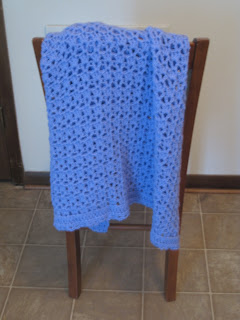A while back, I was Christmas shopping and ran across a crochet book. I flipped through it, and was generally unimpressed, but I did see one afghan pattern that was interesting. I decided not to buy the book because out of dozens of patterns only one was something I'd want and it was over twenty dollars. Earlier this week, I recalled the pattern and decided to try it out as I remembered it. The first attempt was a disaster. There was no way that I would make an entire blanket in the simplistic way the pattern called for, but I liked the overall look, so I got out some paper and figured out a way to make it work. I have since tried to find the original pattern, but I don't remember enough about the source to find it. I don't even know the name of the book or of the pattern.

In any case, the idea of long stitches to blend colors together has merit. There are myriad ways to arrange them to make interesting patterns. This particular one is more complicated than other options, but it's a starting spot.
Some modifications you could try are to skip rows 7-12, which would change the shape of the arrows (to something non-arrow-like) and have them all go in one direction, or to expand it to having lsc7, with an extra row of sc and ch 1 sp, which would make the arrows change direction on their own.
This stitch is one I would normally avoid: it's slower than sc, complicated, and uses up so much yarn. I'm surprised that I like this stitch so much because it doesn't do anything that I normally like stitches to do, and I would not recommend this stitch pattern for beginners or for something you want to work up quickly and easily. However, I'm loving how this is turning out. The overall effect reminds me a little of how quilts feel because it's so solid and the complicated rows fold down the simple rows, making it thicker there, basically at a seam. So far, I've spent about 20 hours, 4 skeins of I Love this Yarn, and have only gotten about 18" of fabric. I guess I was just up for a challenge.
Color Pattern:
Use one color for first 5 rows, then change colors every 6 rows. Change colors at row 6, 12, 18, etc
Stitch Definitions:
lsc2= long single crochet into ch 1 sp 2 rows below
lsc3= long single crochet into ch 1 sp 3 rows below
lsc4= long single crochet into ch 1 sp 4 rows below
lsc5= long single crochet into ch 1 sp 5 rows below
lsc6= long single crochet into ch 1 sp 6 rows below
Note: st = stitch, which can be sc, ch 1 sp, or one of the long sc
Chain a multiple of 6 + 3
Row 1: sc in 2nd ch from hook, [ch 1, sk 1, sc in next 5 ch] across, sc in last 6 ch
Row 2: ch 1, turn, sc in first 5 st, [ch 1, sk 1, sc in next 5 st] across, sc in last 2 st
Row 3: ch 1, turn, sc in first 3 st, [ch 1, sk 1, sc in next 5 st] across, sc in last 4 st
Row 4: ch 1, turn, sc in first 3 st, [ch 1, sk 1, sc in next 5 st] across, sc in last 4 st
Row 5: ch 1, turn, sc in first 5 st, [ch 1, sk 1, sc in next 5 st] across, sc in last 2 st
Row 6: ch 1, turn, sc in first sc, [sc, lsc2, lsc3, lsc4, lsc5, lsc6] across, sc in last st
Row 7: ch 1, turn, sc in first 6 st, [ch 1, sk 1, sc in next 5 ch] across, sc in last 1 st
Row 8: ch 1, turn, sc in first 2 st, [ch 1, sk 1, sc in next 5 st] across, sc in last 5 st
Row 9: ch 1, turn, sc in first 4 st, [ch 1, sk 1, sc in next 5 st] across, sc in last 3 st
Row 10: ch 1, turn, sc in first 4 st, [ch 1, sk 1, sc in next 5 st] across, sc in last 3 st
Row 11: ch 1, turn, sc in first 2 st, [ch 1, sk 1, sc in next 5 st] across, sc in last 5 st
Row 12: ch 1, turn, sc in first sc, [lsc6, lsc5, lsc4, lsc3, lsc2, sc] across, sc in last st
Row 13: ch 1, turn, sc in first 1 st, [ch 1, sk 1, sc in next 5 ch] across, sc in last 6 st
Repeat Rows 2-13 for pattern, ending with either row 7 or 13
 If you enjoy reading crochet blogs, and since you're reading this I assume you do, you should check out Mary Beth Temple's book: Hooked for Life: Adventures of a Crochet Zealot.
If you enjoy reading crochet blogs, and since you're reading this I assume you do, you should check out Mary Beth Temple's book: Hooked for Life: Adventures of a Crochet Zealot.




